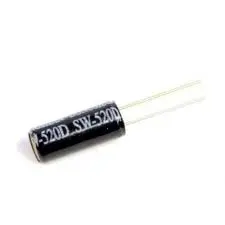Ball Switch SW-520D Tilt Shock Sensor
The Roller Ball Tilt Switch SW-520D is a simple yet effective orientation-sensing device. It is made of environmentally friendly materials and serves as a safer alternative to mercury-based tilt switches. Here’s a summary of key details about the sensor:
Features:
Safer than mercury switches: Uses a ball to make or break an electrical connection, eliminating the risks associated with mercury.
Durable and affordable: The switch is made to last and is reliable for low-current circuits.
Simple to interface: Works well with microcontrollers, making it easy to integrate into projects like robotics or appliances.
Low power: It consumes little power, making it ideal for battery-operated devices.
Working Principle:
Ball mechanism: The sensor contains a metal ball inside a tube. When the sensor is tilted, the ball rolls onto two conductive poles, making or breaking the connection, which can be detected by a microcontroller.
Activation angle: The sensor typically activates when tilted between 30° to 90° from the horizontal.
Circuit & Example Code:
Circuit: Connect an LED to pin 12 of an Arduino and the tilt sensor to pin 4. The sensor can be used to control the LED based on tilt.
Code: The code handles debouncing and updates the LED state based on the sensor's tilt. It’s a simple switch, where the state is read, and the LED is toggled accordingly.
Technical Details:
Voltage: 5V
Max Current: 30mA
Insulation Resistance: >10M ohm
Tilt Angle: Activated between 30° to 90° from horizontal.
Applications:
Robotics: Commonly used in robots to detect orientation.
Automotive: Helps in detecting tilt or roll.
Home Appliances: Used to sense orientation in various devices.
Comparisons:
Mercury Tilt Switch: Uses a liquid mercury bead to complete the circuit when tilted, but can be hazardous due to the toxic nature of mercury. Roller Ball switches are safer and environmentally friendly.
